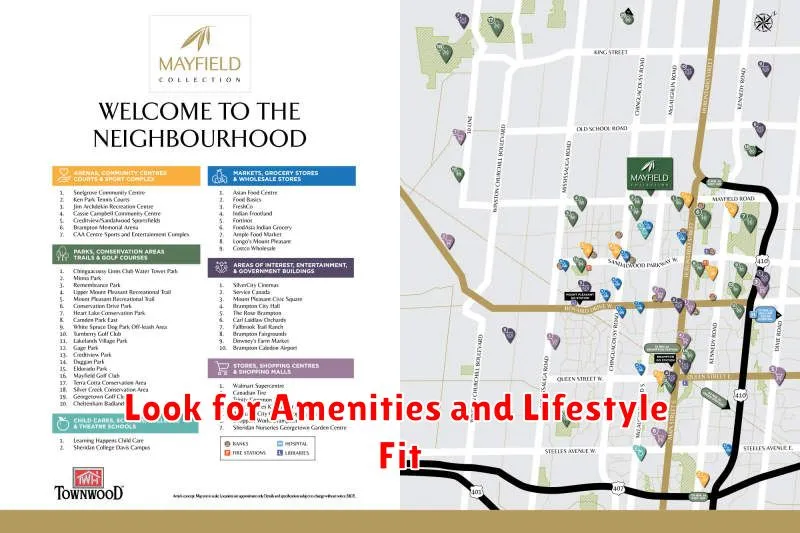Choosing the right neighborhood is a crucial step in creating a fulfilling and enjoyable lifestyle. The ideal neighborhood caters to your individual needs and preferences, offering a sense of belonging and contributing significantly to your overall quality of life. Whether you prioritize safety, convenience, affordability, or access to specific amenities, understanding your priorities is the first step in finding the perfect place to call home. This guide will explore key factors to consider when evaluating potential neighborhoods, helping you make an informed decision and find the perfect fit for you and your family.
From bustling city centers to quiet suburban streets, the options are vast and varied. Navigating the complexities of choosing the right neighborhood requires careful consideration of various lifestyle factors, including commute times, school districts, local businesses, and the overall community atmosphere. This article provides a comprehensive roadmap, outlining the essential steps to take when researching and selecting a neighborhood that aligns with your budget, lifestyle, and long-term goals, ensuring a smooth and successful transition to your new home.
Understanding the Impact of Neighborhood Choice
Neighborhood choice significantly impacts an individual’s quality of life. Location plays a crucial role in determining access to essential amenities such as quality schools, healthcare facilities, and employment opportunities. Furthermore, the safety and security of a neighborhood directly influence residents’ peace of mind and overall well-being. Choosing a neighborhood wisely requires careful consideration of these factors, alongside others like property values, community involvement, and proximity to recreational areas.
Beyond practical considerations, the social environment of a neighborhood shapes residents’ experiences. A strong sense of community can foster social connections and support networks, contributing to a greater sense of belonging and overall happiness. Conversely, neighborhoods lacking cohesion can lead to feelings of isolation and detachment. The demographic composition of a neighborhood, including age, ethnicity, and socioeconomic status, also influences social dynamics and interactions.
Ultimately, the decision of where to live is a personal one. However, understanding the complex interplay of factors that contribute to neighborhood quality is essential for making an informed choice. By carefully evaluating their priorities and researching potential neighborhoods, individuals can select a location that aligns with their lifestyle, values, and long-term goals. This proactive approach can lead to a more fulfilling and enriching living experience.
Factors to Consider: Schools, Crime, Commute
When choosing a place to live, schools, crime, and commute are often top priorities. The quality of local schools is a major factor for families with children. Research school districts, ratings, and programs to ensure they align with your family’s educational goals. Crime rates and statistics can provide insights into the safety of a neighborhood. Consider checking local police reports and online resources for neighborhood-specific crime data. Finally, evaluate the daily commute to work or other frequent destinations. Factor in distance, traffic patterns, and transportation options (public transport, driving, cycling) to assess the impact on your daily routine and lifestyle.
Regarding schools, consider not just test scores but also factors like class size, teacher-student ratio, extracurricular activities, and overall school environment. For crime, it’s important to understand not just the overall crime rate, but also the specific types of crime prevalent in an area. Be sure to consider both property crime and violent crime statistics. With commute, account for rush hour traffic, potential delays, and the cost of transportation, including gas, tolls, and public transport fares.
By carefully considering these three factors, you can make a more informed decision about where to live, choosing a location that best suits your family’s needs and priorities. Balancing these factors with your budget and other preferences will contribute to a higher quality of life in your new community.
Explore the Area at Different Times

Experiencing a location at various times of the day can dramatically alter your perception. The ambiance shifts, revealing different facets of the area. For instance, a bustling market square vibrant with activity during the day might transform into a tranquil, dimly lit space in the evening. Observing these changes provides a deeper understanding of the area’s rhythm and the lives of its inhabitants. Consider visiting during the morning, afternoon, evening, and even late at night to gain a comprehensive perspective.
Light plays a crucial role in shaping how we experience a place. The golden hues of sunrise can cast a warm glow, highlighting architectural details and natural beauty. The harsh midday sun can create strong contrasts, emphasizing textures and colors. As dusk settles, the soft, diffused light can create a more romantic or mysterious atmosphere. These varying light conditions can significantly impact your photographs and overall impression of the area.
Furthermore, different times of day attract different crowds. Weekday mornings may be dominated by commuters, while weekends might see an influx of tourists. Evenings could draw locals out for leisure activities. Observing these patterns can offer insights into the area’s social dynamics and provide a more nuanced understanding of its character.
Talk to Current Residents for Insight

Gaining firsthand perspectives from current residents offers invaluable insight into a community. Speaking directly with those who live there allows you to go beyond brochures and marketing materials, providing a more authentic understanding of the daily experience. Consider asking about aspects such as noise levels, community involvement, parking availability, and the overall atmosphere.
Preparing thoughtful questions beforehand can maximize the information you gather. Inquiries about local amenities, nearby schools, and commuting experiences are often helpful. Additionally, inquiring about any unexpected surprises or challenges they faced after moving in can offer valuable foresight. This direct interaction can paint a clearer picture of what it’s truly like to live in the community.
Residents can provide nuanced perspectives on topics like the responsiveness of management, the upkeep of shared spaces, and the general sense of community. Don’t hesitate to engage with multiple residents to get a broader range of opinions and experiences. This information can prove essential in making an informed decision about whether a particular community is the right fit for your lifestyle.
Look for Amenities and Lifestyle Fit

When choosing a place to live, amenities and lifestyle compatibility are key factors. Think about what matters most to you. Do you need in-unit laundry, a fitness center, or pet-friendly accommodations? Perhaps easy access to public transportation, parks, or nightlife is more your style. Prioritize these needs and wants to narrow down your options.
Consider your daily routine and preferred social scene. Are you a homebody who values peace and quiet, or do you thrive in a bustling environment with social events? Some buildings offer communal spaces like rooftop terraces or shared work areas that cater to specific social preferences. Match the environment to your personality for the best fit.
Balancing your desired amenities with your budget is crucial. While a building with every bell and whistle may be tempting, it’s important to be realistic about affordability. Create a list of must-haves, nice-to-haves, and things you’re willing to compromise on to find the optimal balance of lifestyle, location, and cost.
Use Online Tools for Research
Conducting thorough research often requires utilizing a variety of resources. Online tools can significantly streamline this process. Search engines like Google Scholar and specialized databases offer access to a wealth of scholarly articles, books, and other publications. Citation management tools like Zotero or Mendeley help organize your research and generate bibliographies effortlessly. Exploiting these digital resources can save valuable time and enhance the quality of your research.
Beyond basic search engines, consider exploring subject-specific databases and archives. These platforms often contain curated collections of resources relevant to specific fields of study. For example, JSTOR provides access to academic journals in the humanities and social sciences, while PubMed is a valuable resource for biomedical research. Using these specialized tools can help you quickly locate relevant and authoritative information.
Furthermore, online tools can assist in analyzing and interpreting your research findings. Statistical software packages and data visualization tools can help you make sense of complex datasets and present your results effectively. Remember to evaluate the credibility of any online resource you use, considering factors such as the author’s expertise, the publication’s reputation, and the potential for bias.
Balancing Budget and Location
Finding the right place to live often involves a delicate balance between budget and desired location. Budget constraints can significantly limit housing options, especially in high-cost areas. It’s crucial to realistically assess your income and expenses to determine an affordable price range. Consider not just rent or mortgage payments, but also property taxes, utilities, and commuting costs. Being flexible with your desired location can open up more affordable possibilities.
Location plays a crucial role in lifestyle and overall well-being. Factors to consider include proximity to work, amenities (such as grocery stores, restaurants, and parks), school districts, and the overall safety of the neighborhood. Prioritize what’s most important to you and be prepared to compromise on some aspects. For example, a longer commute might be acceptable if it means living in a preferred neighborhood or saving money on housing.
Research is essential to make informed decisions. Utilize online resources to compare cost of living in different areas, explore neighborhood demographics, and browse available properties. Talking to residents can also provide valuable insights into the realities of living in a specific location. By carefully weighing budget and location factors, you can find a place to live that meets your needs and fits your financial situation.

